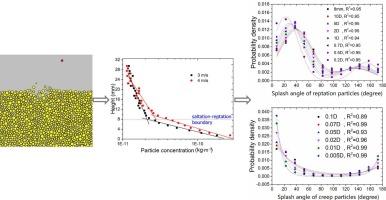A DEM study on the criteria for particle movement over a granular bed
IF 4.5
2区 工程技术
Q2 ENGINEERING, CHEMICAL
引用次数: 0
Abstract
The collision of a spherical particle onto a granular bed, generating a splash of ejected grains, is a crucial process in the study of wind-blown sand. Previous research has faced challenges in clearly distinguishing between particles in saltation, reptation, and creep motion. This study employs the Discrete Element Method (DEM) to simulate particle trajectories during sand-bed collisions, providing a systematic analysis of the vertical mass concentration profiles and the probability density functions (PDFs) for splash velocity, splash angle, and the number of splashed particles associated with saltation, reptation, and creep particles. Our results reveal that reptation motion predominantly occurs within a vertical height range of 0.064 mm to 8 mm above the surface, creep motion occurs below 0.032 mm, and saltation occurs at heights greater than 8 mm.

关于颗粒床上颗粒运动标准的 DEM 研究
球形颗粒碰撞颗粒床,产生喷射颗粒飞溅,是研究风吹砂的一个关键过程。以往的研究在明确区分颗粒的盐化、爬行和蠕动运动方面面临挑战。本研究采用离散元素法(DEM)模拟沙床碰撞过程中的颗粒轨迹,对垂直质量浓度剖面以及与盐化、爬行和蠕变颗粒相关的飞溅速度、飞溅角度和飞溅颗粒数量的概率密度函数(PDF)进行了系统分析。我们的研究结果表明,爬行运动主要发生在离地表 0.064 毫米到 8 毫米的垂直高度范围内,蠕动运动发生在 0.032 毫米以下,盐化运动发生在大于 8 毫米的高度。
本文章由计算机程序翻译,如有差异,请以英文原文为准。
求助全文
约1分钟内获得全文
求助全文
来源期刊

Powder Technology
工程技术-工程:化工
CiteScore
9.90
自引率
15.40%
发文量
1047
审稿时长
46 days
期刊介绍:
Powder Technology is an International Journal on the Science and Technology of Wet and Dry Particulate Systems. Powder Technology publishes papers on all aspects of the formation of particles and their characterisation and on the study of systems containing particulate solids. No limitation is imposed on the size of the particles, which may range from nanometre scale, as in pigments or aerosols, to that of mined or quarried materials. The following list of topics is not intended to be comprehensive, but rather to indicate typical subjects which fall within the scope of the journal's interests:
Formation and synthesis of particles by precipitation and other methods.
Modification of particles by agglomeration, coating, comminution and attrition.
Characterisation of the size, shape, surface area, pore structure and strength of particles and agglomerates (including the origins and effects of inter particle forces).
Packing, failure, flow and permeability of assemblies of particles.
Particle-particle interactions and suspension rheology.
Handling and processing operations such as slurry flow, fluidization, pneumatic conveying.
Interactions between particles and their environment, including delivery of particulate products to the body.
Applications of particle technology in production of pharmaceuticals, chemicals, foods, pigments, structural, and functional materials and in environmental and energy related matters.
For materials-oriented contributions we are looking for articles revealing the effect of particle/powder characteristics (size, morphology and composition, in that order) on material performance or functionality and, ideally, comparison to any industrial standard.
 求助内容:
求助内容: 应助结果提醒方式:
应助结果提醒方式:


